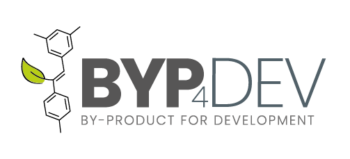GLOSSARY Byp4Dev
Agro-industry:
Industry composed by all economic activities related to the production, industrialization and marketing of products from the agricultural, livestock, forestry and fishing sectors.
Biocompounds/ bio-products / bio-based compounds:
Bio-based products are those products wholly or partly derived from materials of renewable biological origin 1.
Bioeconomy:
Bioeconomy is defined as “an economy where the basic building blocks for materials, chemicals, and energy are derived from renewable biological resources” 2.
Biofuel:
Biofuels are liquid or gaseous renewable transport fuels, such as biodiesel and bioethanol, made from biomass 3.
Biomass Value Pyramid:
The Biomass Value Pyramid shows the entire cascade of value adding products which can be produced from agricultural crop residues and other left over bio materials.
Bioplastics:
Bioplastics are made wholly or in part from renewable biomass sources such as sugarcane and corn, or from microbe such as yeast. Some bioplastics are biodegradable or even compostable, under the right conditions. Bioplastics made from renewable resources can be naturally recycled by biological processes, thus limiting the use of fossil fuels and protecting the environment 4.
Biopolymers:
Biopolymers are polymers produced from natural sources either chemically synthesized from a biological material or entirely biosynthesized by living organisms 5.
Biorefineries:
A biorefinery can be defined as a framework or a structure in which biomass is utilized in an optimal manner to produce multiple products and tries to be self-sustaining and not harmful to the environment 6.
Blueprint:
A service blueprint is a diagram that displays the entire process of service delivery, by listing all the activities that happen at each stage, performed by the different roles involved 7.
By-products:
A product deriving from a manufacturing process or chemical reaction, and not the primary product or service being produced. A by-product can be useful and marketable, or it can have negative ecological consequences 8.
By-products Valorisation:
A product deriving from a manufacturing process or chemical reaction, and not the primary product or service being produced. A by-product can be useful and marketable, or it can have negative ecological consequences 8 .
Circular Economy:
The circular economy is a model of production and consumption, which involves sharing, leasing, reusing, repairing, refurbishing and recycling existing materials and products as long as possible. In this way, the life cycle of products is extended. In practice, it implies reducing waste to a minimum.
Green Technologies:
Green Technology could be defined as set of technologies, help mankind to extract food, feed, fiber, fuel and fertilizer using renewable and non-renewable energies from the environment and live happily with the cultural diversity while maintaining the ecosystem resilience, supporting environment to maintain nutrient cycles, pollination, carbon sequestration and climate regulation, waste decomposition and detoxification, purification of water and air and pest and disease control 9.
Scale-up:
Cambridge Dictionary defines scale-up as “increasing something in size, amount, or production”.
Value-added products:
Value-added products can be defined as all those products obtained after one or more stages of processing, with increased value with respect to the initial raw material 10.
In our case, raw agricultural products that have been modified or enhanced to have a higher market value and/or a longer shelf life.
Wastes:
Unwanted or unusable materials. Waste is any substance which is discarded after primary use, or is worthless, defective and of no use. A waste product may become a by-product through an invention that raises a waste product’s value above zero.
Wastes valorisation:
The term “waste valorization” refers to any industrial processing activities aimed at reusing, recycling, or composting from wastes, useful products, or sources of energy 11.
1: Bio-based products website. European Commission: link.
2: McCormick, K. & Kautto, N. “The Bioeconomy in Europe: An Overview. Sustainability”. 5. Sustainability, 2013.
3: Energy website. European Commission: link.
4: Alfred, R. & Phillip, Ch., “The Elements of Polymer Science & Engineering (Third Edition)”. Chapter 13. Academic Press, 2013
5: Smith, A.M.; Moxon, S. & Morris, G.A., “Wound Healing Biomaterials Volume 2: Functional Biomaterials”. Chapter 13. Woodhead Publishing, 2016.
6: Janakan, S.; Saral, R.S. &Panneerselvam Ranganathan, A., “Hydrocarbon Biorefinery”. Chapter 13. Elsevier, 2022.
7: Servicedesigntool.orgn. https://servicedesigntools.org/tools/service-blueprint
8: United States Environmental Protection Agency: link.
9: Gunasena, Chandima. Green Technology Definition. 2019.
10: Mariano, M, “Sustainable Design for Renewable Processes”. Chapter 8. Elsevier, 2022.
11: Kabongo, J.D., “Encyclopedia of Corporate Social Responsibility”. Waste Valorization. Springer, 2013.
